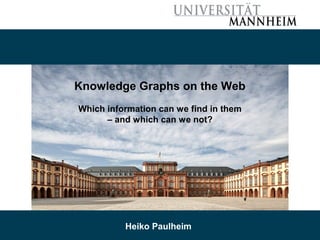The document discusses knowledge graphs, their definitions, creation methods, and the challenges encountered, such as incompleteness and errors. It outlines various knowledge graphs like DBpedia, YAGO, and Wikidata, providing insights into their structures and overlaps. Additionally, it highlights typical errors in knowledge graph data and suggests potential improvements for accuracy and completeness.



























































![08/22/17 Heiko Paulheim 60
Common Errors in Knowledge Graphs
• So far, we have looked at relation assertions
• Numerical values can also be problematic…
– Recap: Wikipedia is made for human consumption
• The following are all valid representations of the same height value
(and perfectly understandable by humans)
– 6 ft 6 in, 6ft 6in, 6'6'', 6'6”, 6´6´´, …
– 1.98m, 1,98m, 1m 98, 1m 98cm, 198cm, 198 cm, …
– 6 ft 6 in (198 cm), 6ft 6in (1.98m), 6'6'' (1.98 m), …
– 6 ft 6 in[1]
, 6 ft 6 in [citation needed]
, …
– ...
Wienand & Paulheim: Detecting Incorrect Numerical Data in DBpedia. ESWC 2014
Fleischhacker et al.: Detecting Errors in Numerical Linked Data Using Cross-Checked
Outlier Detection. ISWC 2014](https://image.slidesharecdn.com/keystonesummerschool2017-170822091320/85/Knowledge-Graphs-on-the-Web-60-320.jpg)






















